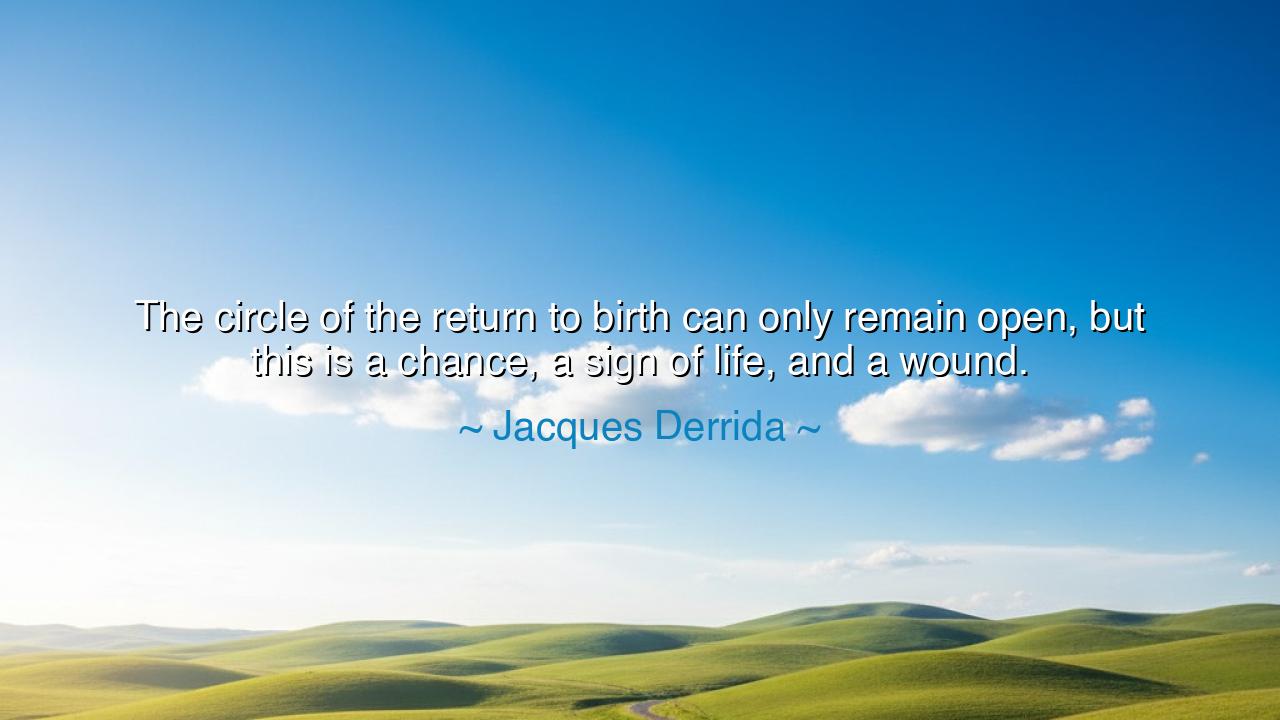
The circle of the return to birth can only remain open, but this
The circle of the return to birth can only remain open, but this is a chance, a sign of life, and a wound.






"The circle of the return to birth can only remain open, but this is a chance, a sign of life, and a wound." These words, spoken by the philosopher Jacques Derrida, weave a complex tapestry of truth, one that speaks to the inexorable nature of life, the cyclical patterns that govern our existence, and the deep mystery of birth and death. The circle that Derrida describes is a metaphor for the endless cycle of life—a cycle that is never truly closed, for it forever remains open to the unknown, to the future, to the return of life again and again. But, in this openness, in this ceaseless return, there is also a wound, a pain that cannot be avoided, for the act of being born, of beginning, is intertwined with the pain of loss and change.
To understand this, we must first recognize that life is not a simple, linear path from birth to death. It is a circle—a continuous cycle, like the turning of the great wheel of fate, where each ending marks the beginning of something new. The ancients understood this well. The Egyptians, for example, saw life and death as part of an eternal cycle governed by the gods. They spoke of the eternal return, where the soul would pass through death and be reborn, returning again to continue its journey. Similarly, the Greeks understood the circle of life through the myths of Persephone and her descent into the underworld, where she was reborn each year, bringing forth the renewal of nature. Life, death, and rebirth—this was the great cosmic rhythm of existence, a rhythm that could not be avoided, only embraced.
But Derrida's words go deeper still. The circle of life is not simply a passage from one form to another; it is an open space, one that is never fully completed, for with each return there is the possibility of something new. A return to birth is always a chance, a moment of possibility, where the future can unfold in ways previously unimagined. It is a moment filled with hope, but also with uncertainty. What is born, what is renewed, is never the same as what came before. Each time the circle turns, it does so with a wound—the wound of change, of impermanence, for life itself is marked by its fleeting nature. We cannot experience life without the knowledge that it is both a gift and a loss—a chance to create, to grow, and to understand, but always with the shadow of death looming over it.
Consider, for a moment, the story of Oedipus, the tragic hero of Greek mythology. His life was one of constant return, a man who could not escape the fated circle that bound him to his past. His actions—however noble they seemed—were part of an endless cycle of fate, where each decision led to a new form of suffering, yet also a new form of awareness. He was born into a world that offered him a chance at greatness, only to be struck by the wound of fate and self-discovery. His story, like all great tragedies, speaks to the unavoidable return of certain truths, and the suffering that accompanies the attempt to escape them. In this, we see that the circle of life is never closed, for it is in the opening of the wound, in the painful return to understanding, that we find growth and transformation.
This cyclical nature of existence—the way in which each birth leads to a new challenge, a new wound, a new chance—is reflected in the experiences of every person. As we live our lives, we are constantly returning to the past, to memories, to lessons learned. Yet, each time we do so, we are not the same as before. We have been shaped by our experiences, our triumphs, and our failures. The wound of living—the suffering, the loss, the impermanence—is what gives us the strength to continue. It is what allows us to evolve and to create something new, something that transcends what came before.
The lesson, then, is one of embracing the cycle—not as something to be feared, but as something to be lived with awareness. To live fully is to accept that each moment is both a gift and a wound, both an opportunity and a reminder of what is fleeting. Just as the phoenix rises from the ashes, so too do we, each time we face loss or struggle, have the chance to renew ourselves, to be reborn into something greater. But to do this, we must not shrink from the wound of life. We must meet it with the knowledge that the pain of living is an essential part of the return. It is through the wounds that we are marked and, through that mark, we find our path forward.
And so, let us take these words of Derrida as a guide: in the face of the endless cycle of birth and death, let us find meaning in our openness to life. Let us recognize that the chance to live is never without its cost, but that this cost is what makes our journey worthwhile. Each day, each breath, is a return, and in every return, there is both suffering and growth. Let us not shy away from the wounds life offers us, for it is through them that we are shaped, that we are given the chance to reach new heights, to learn, and to live fully.






AAdministratorAdministrator
Welcome, honored guests. Please leave a comment, we will respond soon